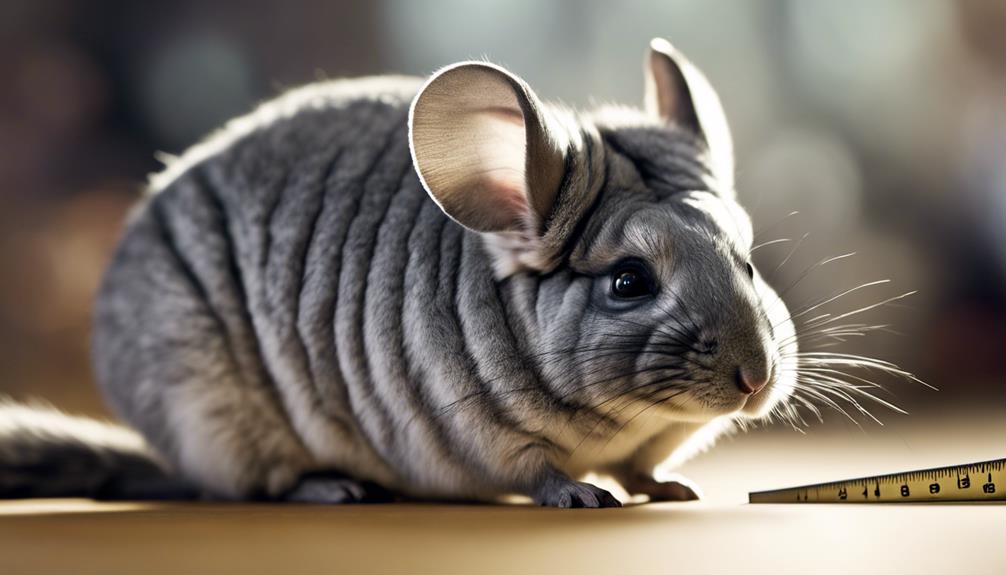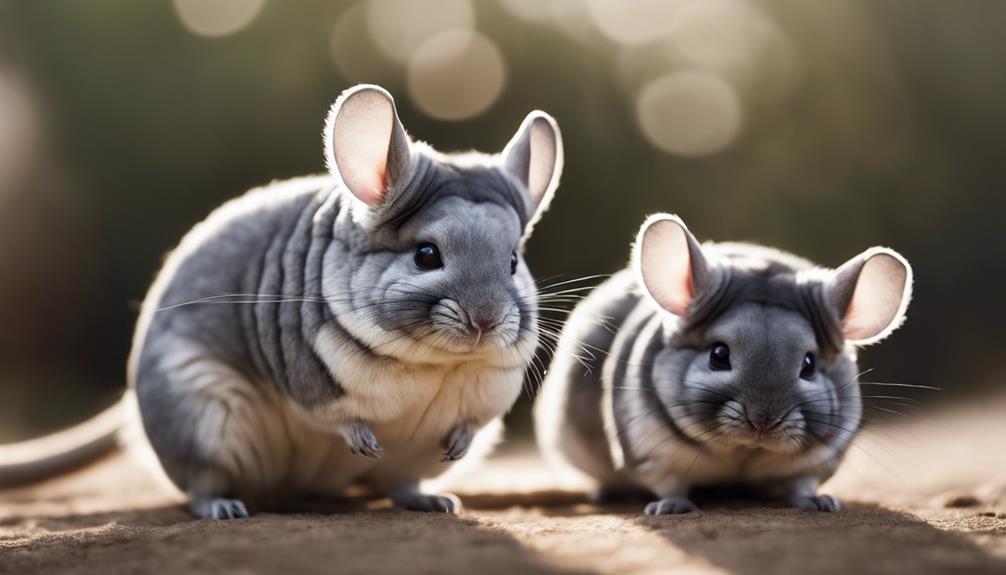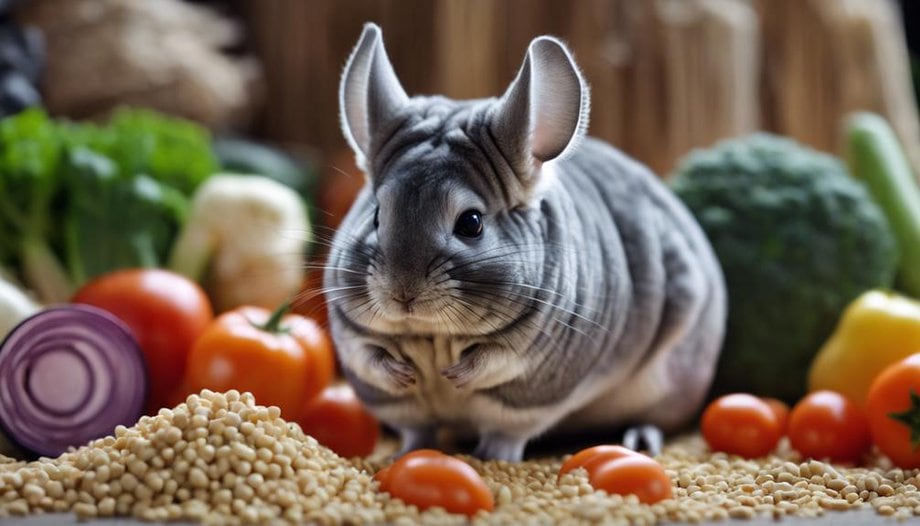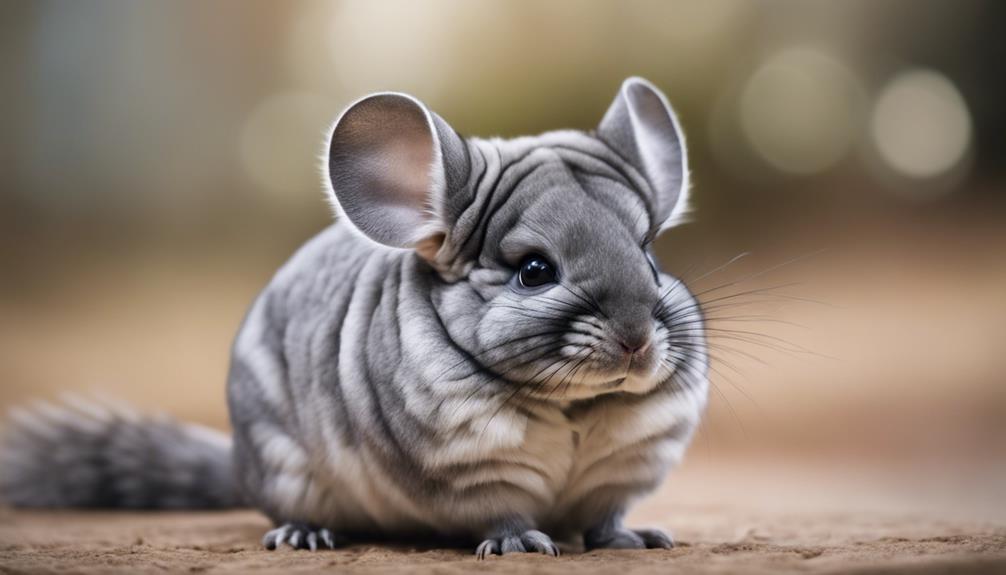When Do Chinchillas Reach Full Size? Growth Patterns Explained

At this age, they usually weigh between 1 to 1.5 pounds.
Chinchillas are known for their soft and dense fur, which helps them stay warm in their native Andes Mountains habitat.
Chinchilla Growth Phases
During the chinchilla growth phases, these small mammals undergo distinct developmental stages characterized by rapid physical changes. Chinchillas experience growth spurts at specific intervals during their development. These growth spurts are crucial periods where the chinchilla's body undergoes significant changes, such as increased bone length and muscle mass.
The development stages in chinchillas can be categorized into infancy, juvenile, and sub-adult stages. In the infancy stage, chinchillas are born blind and hairless, relying entirely on their mothers for nourishment and warmth. As they transition into the juvenile stage, their fur starts to grow, and they become more active and curious about their surroundings.
During the sub-adult stage, chinchillas reach sexual maturity, and their growth rate starts to slow down. It's essential to provide adequate nutrition during these growth phases to support healthy development. By understanding the growth patterns and development stages of chinchillas, owners can ensure proper care and support for their beloved pets.
Factors Influencing Growth

Factors that influence the growth of chinchillas include genetics, diet, environmental conditions, and overall health status. Genetic predisposition plays a crucial role in determining the potential size and growth rate of chinchillas. Hormonal influences, such as those related to reproductive cycles, can also impact growth patterns.
- Genetic Predisposition: Chinchillas inherit certain growth traits from their parents, affecting how quickly they reach full size.
- Hormonal Influences: Hormones play a significant role in regulating growth processes in chinchillas, with variations impacting growth rates.
- Exercise Habits and Social Interactions: Adequate exercise and positive social interactions can contribute to healthy growth in chinchillas. Engaging in physical activities and having companionship play essential roles in promoting overall well-being, which in turn influences growth patterns.
Understanding these factors and providing appropriate care tailored to the individual chinchilla can help ensure healthy growth and development throughout their life stages.
Size Milestones in Chinchillas

Chinchilla size milestones are crucial indicators of their development, influenced by growth rate variations and environmental factors. Understanding these milestones can provide valuable insights into the overall health and well-being of chinchillas.
Growth Rate Variations
Size milestones in chinchillas mark significant stages of growth and development, reflecting the variations in growth rates observed within this species.
Key Points:
- Size Fluctuations: Chinchillas experience fluctuations in growth, with periods of rapid development followed by slower phases.
- Growth Spurts: These small rodents undergo growth spurts at specific intervals, leading to noticeable changes in size over short periods.
- Individual Variances: While there are general growth patterns, individual chinchillas may exhibit variations in their growth rates influenced by factors like genetics, nutrition, and overall health.
Understanding these growth rate variations is essential for chinchilla caretakers to provide appropriate care and monitor the health and development of their pets effectively.
Environmental Influences
Influenced by their surroundings, chinchillas experience distinct size milestones marking key stages of growth and development. Temperature regulation plays a crucial role in determining the growth rate of chinchillas. Optimal ambient temperatures between 60-70°F are essential for chinchillas to thrive, ensuring their metabolic processes function efficiently. Fluctuations outside this range can impact their growth trajectory, potentially leading to stunted growth or health issues.
Additionally, social interactions within chinchilla communities can influence their growth patterns. Positive social bonds and interactions contribute to a stress-free environment, promoting healthy growth and development. Conversely, social isolation or aggression can hinder growth milestones.
Growth Rate Differences

Understanding the growth rate differences in chinchillas provides valuable insights into their developmental patterns. These differences are influenced by various factors such as hormonal imbalances and genetic variations, leading to distinct growth trajectories among individuals.
Key Points:
- Growth rate disparities: Chinchillas exhibit varying growth rates due to hormonal factors affecting their development. Hormones like growth hormone and thyroid hormones play crucial roles in regulating chinchilla growth, leading to differences in size and maturation rates.
- Size differences: Genetic influences also contribute significantly to the growth rate differences observed in chinchillas. Genetic variations impact an individual chinchilla's potential size, determining how quickly they reach full maturity and their ultimate size as adults.
- Developmental patterns: Understanding these growth rate differences is essential for monitoring the health and well-being of chinchillas. By recognizing the impact of hormonal factors and genetic influences, caretakers can tailor their care routines to support optimal growth and development in these unique animals.
Monitoring Growth Progress
Monitoring the growth progress of chinchillas involves closely tracking their developmental milestones and assessing any deviations from expected growth patterns. Growth tracking is crucial in ensuring the well-being and health of these small mammals. Chinchillas go through distinct developmental stages, with each stage having specific growth indicators that need to be monitored.
During the early stages of life, chinchillas experience rapid growth, with noticeable changes in size and weight. It's essential to monitor this phase closely to ensure that the chinchilla is meeting the expected growth milestones. As they progress through adolescence, chinchillas continue to grow, albeit at a slower rate. Regularly weighing the chinchilla and comparing the measurements to growth charts can help in tracking their development accurately.
Monitoring growth progress also involves observing other factors such as fur quality, activity levels, and appetite. Any deviations from normal growth patterns should be promptly addressed by consulting a veterinarian. By diligently tracking the growth of chinchillas and identifying any issues early on, owners can ensure the overall health and well-being of their furry companions.
Nutrition's Role in Development

Nutrition plays a crucial role in the development of chinchillas, providing essential nutrients necessary for growth.
The impact of diet on chinchilla growth patterns is significant, as it directly influences their overall health and development.
Ensuring a well-balanced diet rich in the necessary nutrients is key to promoting optimal growth in chinchillas.
Essential Nutrients for Growth
During periods of rapid growth, chinchillas require a precise balance of essential nutrients to support their development effectively. To ensure optimal growth and development, chinchillas must receive adequate amounts of key nutrients.
Here are three essential nutrients crucial for chinchilla growth:
- Protein: Vital for muscle and tissue development, chinchillas require high-quality protein sources such as timothy hay and pellets.
- Vitamins and Minerals: Chinchillas need a variety of vitamins like Vitamin C and minerals such as calcium for bone health and overall growth.
- Fiber: Essential for proper digestion and gut health, fiber-rich foods like hay are crucial in a chinchilla's diet to support growth and development.
Providing a well-balanced diet rich in these nutrients is essential for the healthy growth of chinchillas.
Impact of Diet
A chinchilla's growth and development significantly depend on the precise balance of nutrients provided in its diet. Dietary requirements play a crucial role in ensuring the optimal growth of these small mammals. Chinchillas require a diet that's high in fiber, moderate in fat, and low in sugar to support their growth and overall health.
The nutritional balance of their diet must include a variety of hay, pellets, and limited treats to meet their specific needs. Providing the correct nutrients in the right proportions is essential for chinchillas to reach their full size and develop properly. Monitoring their diet closely and adjusting it as needed is key to promoting healthy growth and preventing potential health issues related to nutritional deficiencies.
Ensuring Healthy Growth

To promote optimal growth in chinchillas, maintaining a balanced diet rich in essential nutrients is crucial. A balanced chinchilla diet should consist mainly of high-quality hay, supplemented with limited pellets, fresh vegetables, and occasional treats. Additionally, providing clean water at all times is essential for proper hydration and digestion. Here are three key points to ensure healthy growth in chinchillas:
- Exercise Habits: Encouraging physical activity through the use of chinchilla-safe toys and exercise wheels is vital for their overall well-being. Regular exercise helps prevent obesity, promotes muscle development, and supports healthy bone growth.
- Health Checkups: Regular veterinary checkups are essential to monitor the chinchilla's growth progress, detect any health issues early on, and ensure that they're receiving adequate nutrition. A veterinarian can also provide guidance on adjusting the diet or exercise routine if needed.
- Environmental Enrichment: Providing a stimulating environment with hiding places, platforms, and safe chew toys can help reduce stress levels, promote mental stimulation, and contribute to the chinchilla's overall happiness and well-being.
Frequently Asked Questions
Can Chinchillas Experience Growth Spurts During Specific Stages of Their Development?
Chinchillas can experience growth spurts during specific stages of development due to hormonal influences. These spurts require appropriate nutritional support to maintain healthy growth patterns. Monitoring diet and providing balanced nutrition is crucial.
Are There Any Genetic Factors That Can Affect a Chinchilla's Growth Potential?
In understanding chinchilla growth potential, genetic factors play a key role. These factors can influence a chinchilla's nutritional requirements and exercise benefits, impacting its overall development. A balanced approach is crucial for optimal growth.
How Can Environmental Factors Such as Temperature and Humidity Impact a Chinchilla's Growth Rate?
Environmental factors like temperature and humidity can affect a chinchilla's growth rate. Proper diet and exercise positively impact growth. Social interactions also play a role. Monitoring and controlling these elements can support healthy development in chinchillas.
Do Chinchillas From Different Breeds or Lineages Have Varying Growth Patterns?
Chinchillas from various breeds or lineages exhibit distinct growth patterns. Breed differences influence growth rates, with variations in size and development. Lineage impacts growth trajectory, leading to diverse rates of maturation and physical characteristics among chinchillas.
Are There Any Specific Signs or Symptoms to Watch for to Ensure That a Chinchilla Is Growing at a Healthy Rate?
Watching for weight milestones and dietary changes, along with observing physical appearance and activity levels, can help ensure a chinchilla is growing at a healthy rate. This proactive approach can prevent potential health issues.











